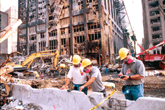 |
| Firefighters scan information from the recovery site into ruggedized Symbol Technologies PPT 2800 handheld devices. |
|  |
| After
heroic efforts at the World Trade Center, New York City’s Fire
Department had the Herculean task of documenting human remains found in
the rubble.

Anyone at the site—a policeman, a crane operator or
a Federal Emergency Management Agency official—who discovered a body
part had to notify the fire department.

A firefighter would then collect the remains and write down a tracking number, date, time, description and location.

The Fire Department mapped Ground Zero into grids
and cells. A fireman might locate the remains as “in grid B, cell 7,”
write it on a slip of paper and take it to the quadrant command center.
A FEMA agent would then transcribe the note and enter it into a
database.

Not only was this laborious for the firefighters,
but the working conditions were hellish, said Greg Fuchek, vice
president of sales for LinksPoint Inc. of Norwalk, Conn.

For six months after Sept. 11, the ground temperature varied between 600 degrees Fahrenheit and 1,500 degrees, sometimes higher.

“In the first few weeks, sometimes when a worker
would pull a steel beam from the wreckage, the end of the beam would be
dripping molten steel,” Fuchek said.

The firefighters’ handwriting sometimes was misread, introducing errors into the database, Fuchek said.

After a few days, the entire team said, “Enough.”
On Sept. 19, fire officials met with the New York City IT and
Telecommunications Department and Alan Leidner, director of the
citywide geographic information system, to figure out a better process.

“They knew they needed to do two things,” Fuchek
said. “They needed to alleviate the firefighters having to write stuff
down, and they had to get the location information of the remains.”

The Fire Department decided to use LinksPoint’s
GlobalPoint Global Positioning System receiver, which clips onto a
Symbol PPT 2800 ruggedized Pocket PC terminal from Symbol Technologies
Inc. of Holtsville, N.Y.

The Symbol handheld can work in rain, extreme cold
or extreme heat. Fuchek said it can be dropped onto concrete from a
height of about four feet without damage. It runs the Microsoft Pocket
PC 2002 operating system on a 206-MHz Intel StrongArm SA-1110 processor
with 64M of RAM.

A scanner is built in, so medical examiners could
assign the remains bar codes that could be scanned without hand-copying
numbers.

Guided help

A pop-up menu guided the firefighters through the
data collection process by asking a series of questions: If an item was
human remains that could be categorized, was it police, fire, Port
Authority or other civilian remains? A policeman’s remains were
recorded in the GIS as a blue dot, a fireman as a red dot, a Port
Authority official as a yellow dot and so on.

The GPS device automatically noted the latitude and
longitude of the item as well as its location on the city’s Ground Zero
grid. One Symbol unit could hold 5,000 such records, Fuchek said.

The buttons were large enough for firefighters to
use with gloved hands. At the end of a shift, a firefighter would come
back to the firehouse and drop the Symbol unit into a cradle to
synchronize the stored data with the city’s GIS.

City officials could then print out updated maps to
show where most of the remains were found and where to concentrate
search efforts.

From Sept. 25 through May 30, the day Ground Zero
operations were declared finished, the Fire Department cataloged 7,000
items using the system.

|